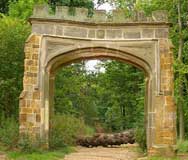
Step into another world
You don”t need to be Johan Eliasch, the Swedish multimillionaire who bought 400,000 acres of Amazonian rainforest to “save” it, to own your own wood.
Fifty paces into this piece of British woodland and the roar of the road gives way to birdsong. A pheasant flutters from the scrub and a fat hare thumps off in the direction of a stream. You are in the world of gleaming Arthurian knights stepping from between the sun-striped, mossy tree trunks.
You are in Cats Wood, a six-acre stand of mature oak with a coppiced hazel and chestnut off the A21 in Kent, south-east England, and for 39,000 sterling ($85,000) it could be yours. The same opportunities exist in the Catskills in upstate New York or Northern Ontario (but without the Arthurian knights of legend).
That moderate price quoted above for a bit of English countryside is about average, in spite of the relative scarcity of a commodity that once covered the entire country.
The problem is ensuring that you can make use of the wood once you have bought it � all too often the main dealers in small parcels of woodland make you sign a pledge that you will not live there. But that can still allow you to make it a second home.
Neolithic Britons began clearing the British “wildwood” surprisingly early. By 500BC almost half of it was gone and in 1086 the Domesday Book records almost no virgin forest remaining. British woods today are mainly the remnants of old royal and other cultivated forests, the felling of which continued until the early 20th century, by which time the UK, with a mere five per cent of tree cover, was virtually bald. Although that percentage has since doubled and continues to rise, Britain remains one of the least forested countries in Europe.
Woods are of the moment, not only in the sense that bluebells carpet them this month: later in May, as the highlight of its Festival of Trees, Kew Gardens in London is to open a stupendous-sounding 200-metre-long walkway through a vertiginous canopy of lime, oak and chestnut trees.
Despite what you might think of “privatised” ecology, be it on a small scale or that of philanthropic millionaires, buyers are increasingly motivated by the desire to conserve a bit of still scarce British woodland. Yet there are many reasons to own a wood. Woodland owner Gill Hernon, says she likes to “spend a whole day” in her “open and sunny” 10-acre Sussex patch of birch, beech and young oak trees, which she has owned since February. “The nice thing about having a wood is all its aspects,” she says. “Camping in the summer, cutting back the brambles, photography – I also like to do amateur painting – finding out about the flora and fauna and the local history. Mine has been a managed, coppiced wood since at least 1600. You can tell, because the oaks grow in rows, that they were part of a plantation. I gather they were probably used to feed furnaces in the ironmaking industry.”
Martin Keelor spends his time in his nine-acre North Wood, in Kent, wildlife-watching, building fires and carving wood products that are, he cautions, “at an experimental stage”. Maintenance involves “a bit of brushcutting. Along with keeping the grass down, this takes more time in the summer; in the winter, I spend a few days clearing wind-thrown trees”.
“I bought the wood to learn the skills of looking after a landscape. It’s also been a good investment: it’s more than doubled in price since I bought it four years ago.”
And some earn their livelihood from the land – like Ben Law, whose house deep within, and constructed entirely from, Prickly Nut Wood in west Sussex indeed resembles something out of the Brothers Grimm. Law, yanked from rustic obscurity when the British Channel 4 television programme Grand Designs filmed his construction of his forest house, not only runs his coppiced products, greenwood-building and charcoal business from his wood but is sustained by it in a more basic way. “I eat a lot of squirrels, rabbit and pigeon from the wood,” he says, “as well as wild garlic and fruit from our small garden.”
However, other countries have more woodland to play with and might have less stringent planning laws. In France, estates tend to be much larger than in the UK, as would be your chances of building a forest cottage; in North America, the woods are bigger still.
“In Ontario, private woodlots range from a couple of acres to 30,000,” says Wade Knight, executive director of the Ontario Woodlot Association, “and in most cases planning laws would permit a house.”
Around 50 per cent of Knight’s members generate revenue from their land, selling hunting leases or forest products such as maple syrup and mushrooms. The remainder own their woods for “aesthetic” reasons, including watching, and presumably occasionally running from, beasts whose fearsome like are long extinct in Britain, including moose, black bears and coyote.
Auto Amazon Links: No products found.
